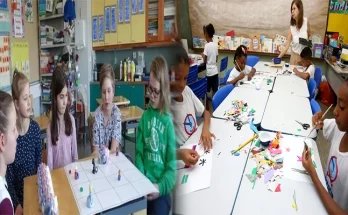STEM education is a growing field, and for good reason. STEM stands for science, technology, engineering and math, and it’s a broad subject that encompasses many different areas of study. It allows students to explore their interests in inventive ways, but it can also be difficult to teach effectively without boring the class. Here are some tips on how teachers can adapt their teaching techniques when teaching STEM subjects:
Introduce concepts in a way that is relevant for students.
- Make sure the lesson is relevant to students.
- Use examples that students can relate to.
- Teach in a way that interests the students and their learning style, not yours!
Use hands-on activities to teach content.
Hands-on activities are engaging for students. Students learn better when they interact with the content, and hands-on activities provide an opportunity for students to do just that. Hands-on learning can be used to teach STEM concepts, as well as reinforce and demonstrate understanding of those concepts. Students can use a variety of tools including technology (like robotics kits), art supplies/materials (such as paintbrushes), or simple household items (such as measuring cups) in order to develop their understanding of STEM topics such as physics or biology through experimentation or observation.
Encourage students to be creative and solve problems on their own.
- Encourage students to be creative and solve problems on their own.
- Teach students how to think critically, problem solve, and be innovative.
- Allow for group work in order to allow for collaboration and discussion among peers.
Provide students with opportunities to present their findings to the class.
- Provide students with opportunities to present their findings to the class.
- Students can present their findings to other classes.
- Students can present their findings online.
- Students can present their findings to local businesses and community organizations, such as libraries or museums, who may be interested in learning more about what your students have discovered through STEM activities or projects that they’ve done in class (or otherwise).
Find ways to link STEM topics with literacy and career readiness skills.
- STEM topics can be used to teach literacy. For example, if you’re teaching a lesson on the water cycle, you could have students write an essay about what they think will happen if we don’t conserve water.
- STEM topics can be used to teach career readiness skills. For example, if your students are learning about electricity in science class and need to create an electric circuit for their project at home, have them write down what materials they need and how much time it will take them so that parents know what’s needed before coming into the classroom (and don’t forget safety precautions!).
- You can use both techniques at once! If you’re teaching a lesson on plants with your science class but want them also develop their reading skills by writing down facts about each plant they discover along with its name and location on Earth (or whatever planet), then this is one way where both subjects would intersect seamlessly without any extra effort required from either party involved–and who doesn’t love seamless?
Break up assignments into multiple parts and give students time to reflect.
You may have heard the term “learning by doing,” which refers to the idea that students learn best when they are actively engaged in the learning process. This can take many forms, including hands-on activities or projects that require students to apply their knowledge in new ways. However, it’s important for teachers and instructors to recognize that there are other ways for students’ brains to engage with material beyond simply completing an assignment or test at the end of class.
We know from research that giving yourself time between receiving new information and applying it helps you retain more information over time (see this article). So rather than having one large project due at the end of each semester or quarter, consider breaking up your assignments into smaller pieces throughout each unit/course period. At first glance this might seem like extra work–but if done correctly it can actually save you time because it gives all parties involved (students included) more opportunities throughout each course period where they can reflect on what they’ve learned so far before moving forward into uncharted territory!
Ask students to write about how they would explain their project or answer questions about it, instead of just asking them to do it again for the sake of getting it right.
Asking students to write out their answers is a great way to get them thinking through the problem, but it’s also important to have them explain their solutions. Asking students to write out the process they used and why they chose that process can help you see where they may be struggling or have misconceptions.
You could also give them time at the beginning of class or before an assignment deadline so they can ask questions if they’re confused about anything related to your instructions or expectations. It’s better for everyone involved if you give yourself opportunities throughout the semester (or year) rather than just at its end!
STEM education can be made more engaging by changing how we teach it
- STEM education can be made more engaging by changing how we teach it.
- The most effective way to do this is to make the content relevant to students’ lives and interests, which allows them to apply what they’ve learned in the classroom outside of it.
- Hands-on activities are a great way for students to learn about STEM subjects, especially when paired with creative problem solving. This approach allows them to develop their own ideas and solutions before learning how others did it in the past–a practice that encourages innovation in both science and technology fields.
- Encourage your students to be creative with their projects by providing opportunities for self-expression through presentations or other forms of communication (such as writing).
We hope that these strategies will help you to transform your STEM classroom into a place where students are excited about learning and eager to explore new topics. By incorporating these ideas into your teaching, you can create a more engaging environment for all students–even those who don’t normally enjoy science or math!





